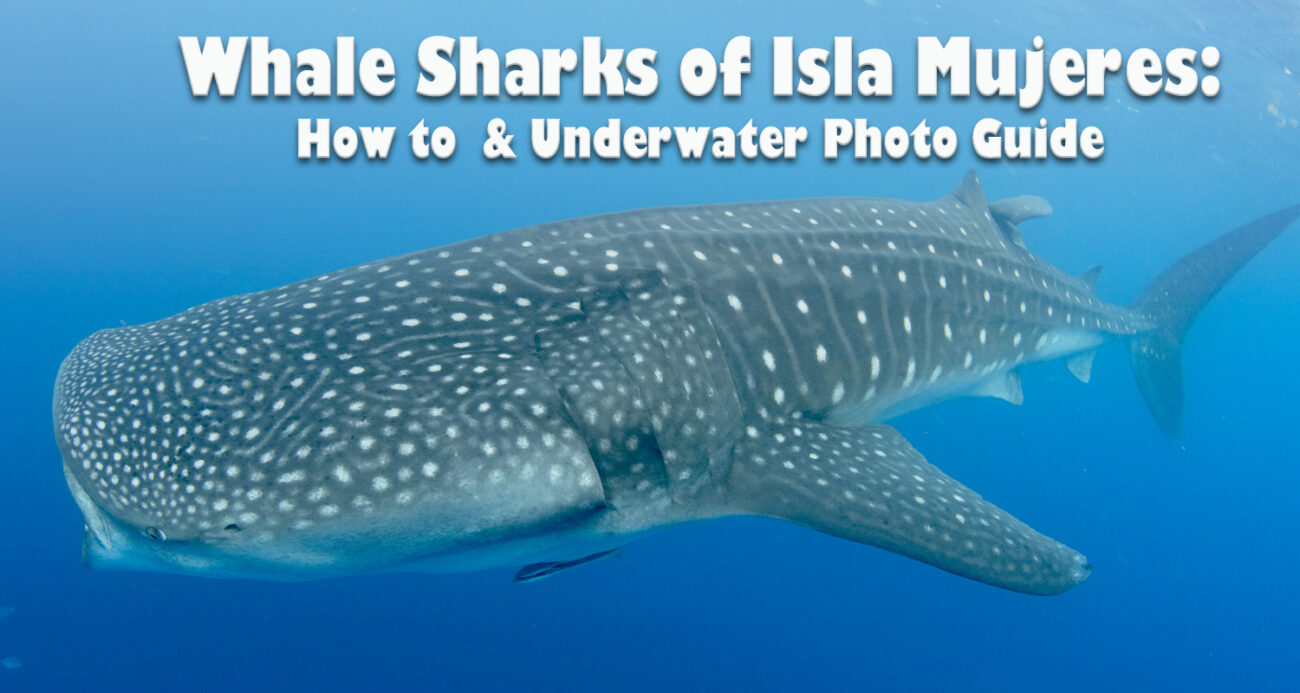
If you are planning to get away this summer, there is no better place than Isla Mujeres, Mexico in the Cancun area to combine unique and exciting whale shark encounters with a fun and vibrant beach vacation. The annual aggregation of hundreds of whale sharks to the waters off Isla Mujeres is the best place in the world to snorkel with full sized gentle giants granting encounters with multiple whale sharks and giant manta rays. Scuba, Mayan ruins, cenotes, beaches and fishing are all easily combined with the high quality in water experience of snorkeling with whale sharks. Isla Mujeres is ready to offer a quality destination with easy travel.
Whale sharks can be found in all tropical and warm-temperate waters. The fish are largely pelagic, staying in the open ocean and thus, chance encounters with whale sharks in many diving locations are possible, but extremely rare. To have a chance to swim with and photograph whale sharks in an area already welcoming to tourists and divers is an opportunity not to miss.
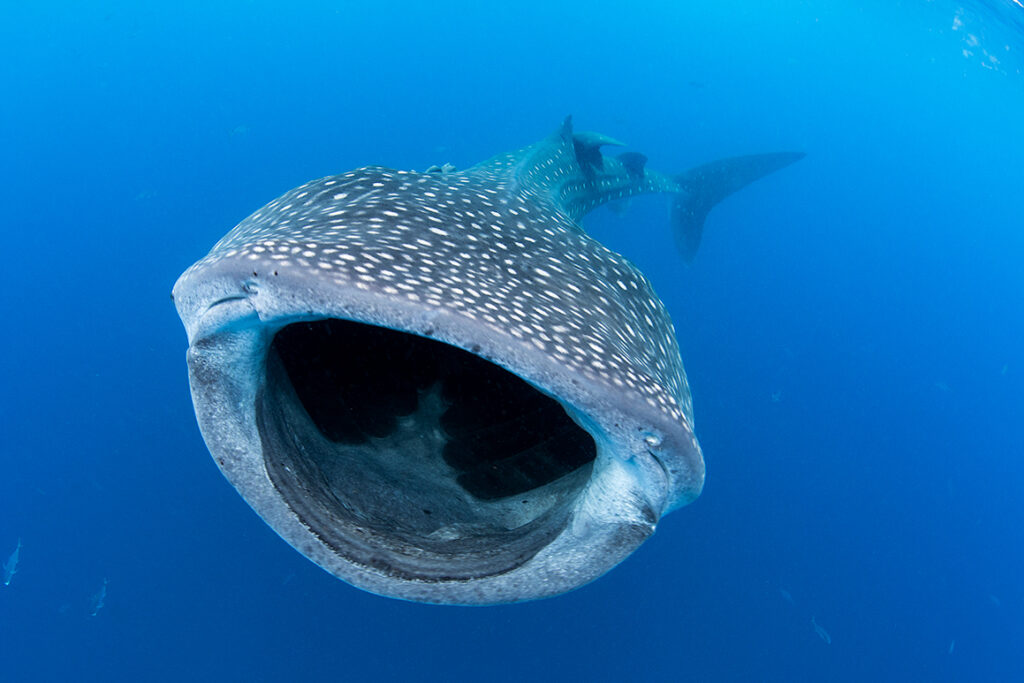
The island Isla Mujeres is offshore of the tourist and beach haven of Cancun, Mexico and provides excellent access to the whale sharks and mantas gathered in the surrounding waters between mid-June and late August. Isla Mujeres is already known as a sport fishing destination which has long promoted catch and release of sailfish and mako sharks. This community of fishermen and captains were the catalyst for whale shark ecotourism. Since the beginning, the Mexican government has coordinated with local biologists and local captains to create specific viewing and encounter regulations aimed to make this safe for the whale sharks, people, and sustainable.
Since the discovery of the whale shark aggregation, researchers have established tagging and tracking programs and have been rewarded with astonishing maps of their travels and potential answers to mysteries such as where they give birth. The giant manta population has also been studied through the Manta Trust Caribbean project. They have established the first manta ray ID database in the Mexico Caribbean and have recorded over 450 individuals since 2013. I am proud to have contributed images for the id database each year. Through the research they have learned that some of the mantas are annual visitors to the area duplicating the actions of some individual whale sharks.
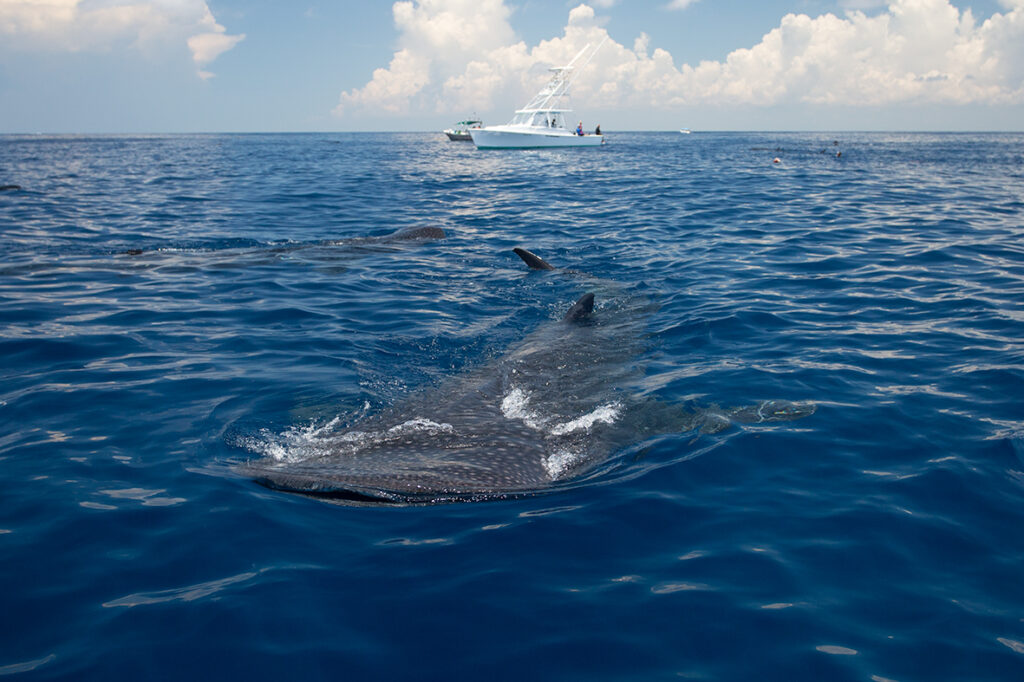
When asked to describe what it is like in the water with whale sharks, I keep coming back to the image of standing in the street with a bus coming at me. It is thrilling and humbling to be in the water observing the life of a whale shark.
Options for encounters range from ½ day boat excursions to immersive 4 or 5 day programs lead by photographers and researchers with small groups and their own boats with full days on the water. The annual trip hosted by Gregory Sweeney Photo Tours is a small group ecotour comprised of 4 full days out on the water for whale sharks and mantas, a beachside hotel on Isla Mujeres, photography mentor and guide, and golf carts to get around.
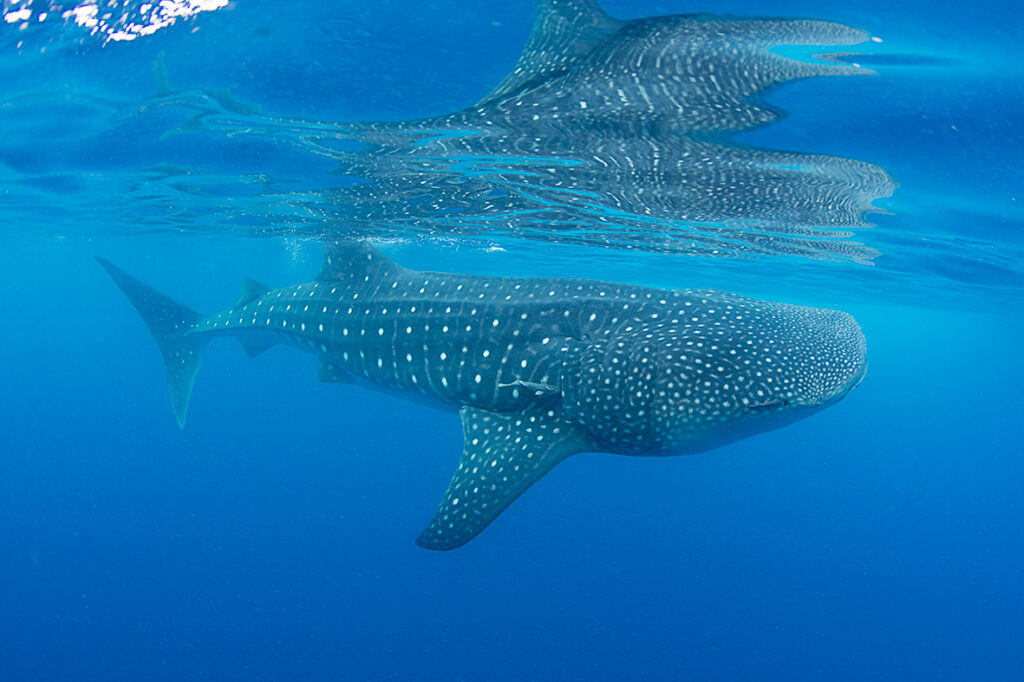
See Details about my next Whale Shark Trip to Mexico
First you will see the whale sharks from on the boat: a dorsal fin and the tip of their tail making a wandering sweep of the surface. As it approaches the boat you may see the upper lip of the wide-open mouth with water spilling in.
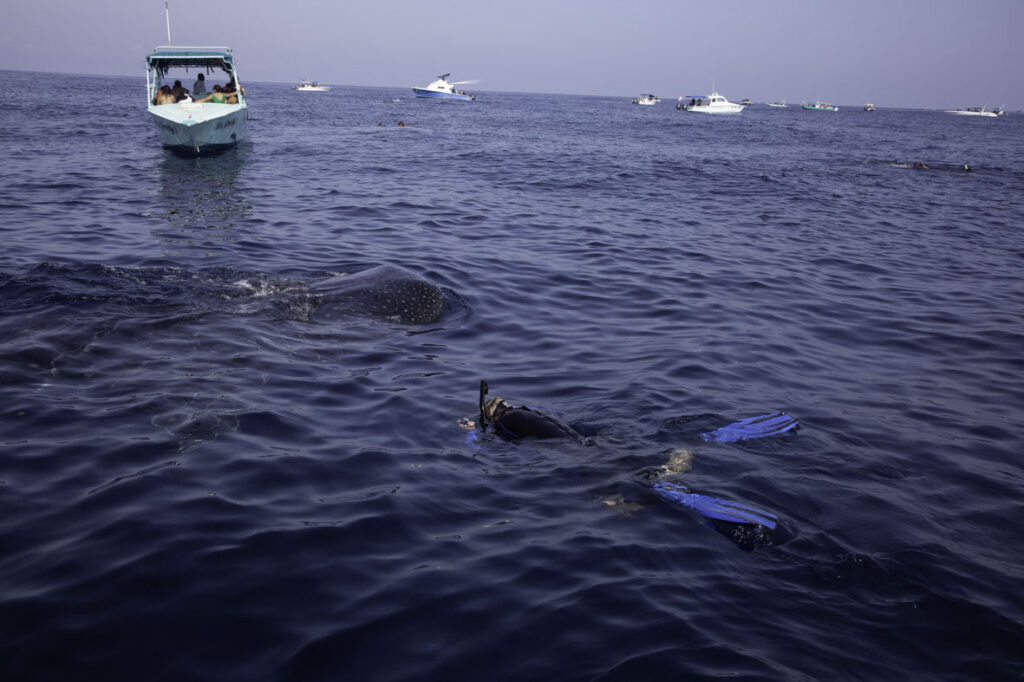
We get in the water by maneuvering ahead of a whale shark. Snorkelers and a guide enter the water and if all works out, the whale shark shortly thereafter comes straight at them. After keeping pace with it for a while it is possible to stop and look around to find another whale shark coming in your direction. We have also witnessed dolphins hunting the small fish also feeding on the bonito eggs.
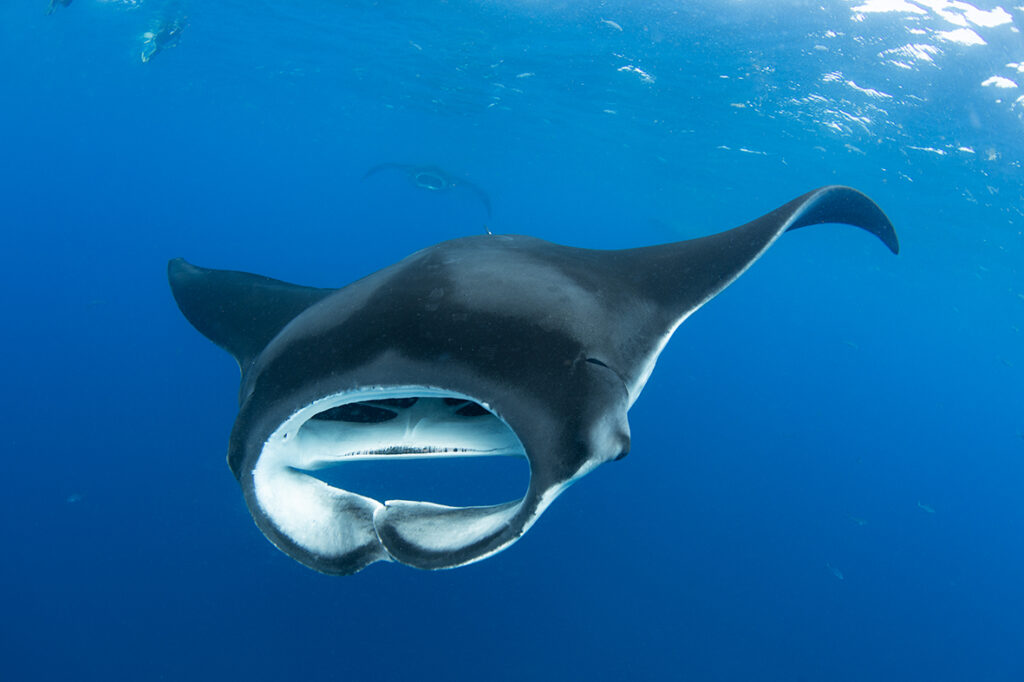
The giant mantas are usually separate from the whale sharks and when I lead groups, we set aside specific times to leave the whale sharks and seek out the mantas. The captains have become very good at finding them despite the challenge presented by the mantas staying below the surface. Most days we can find whale sharks, but not every day has the best conditions for spotting mantas so it is fortuitous that we have multiple days to work with incase of bad weather.
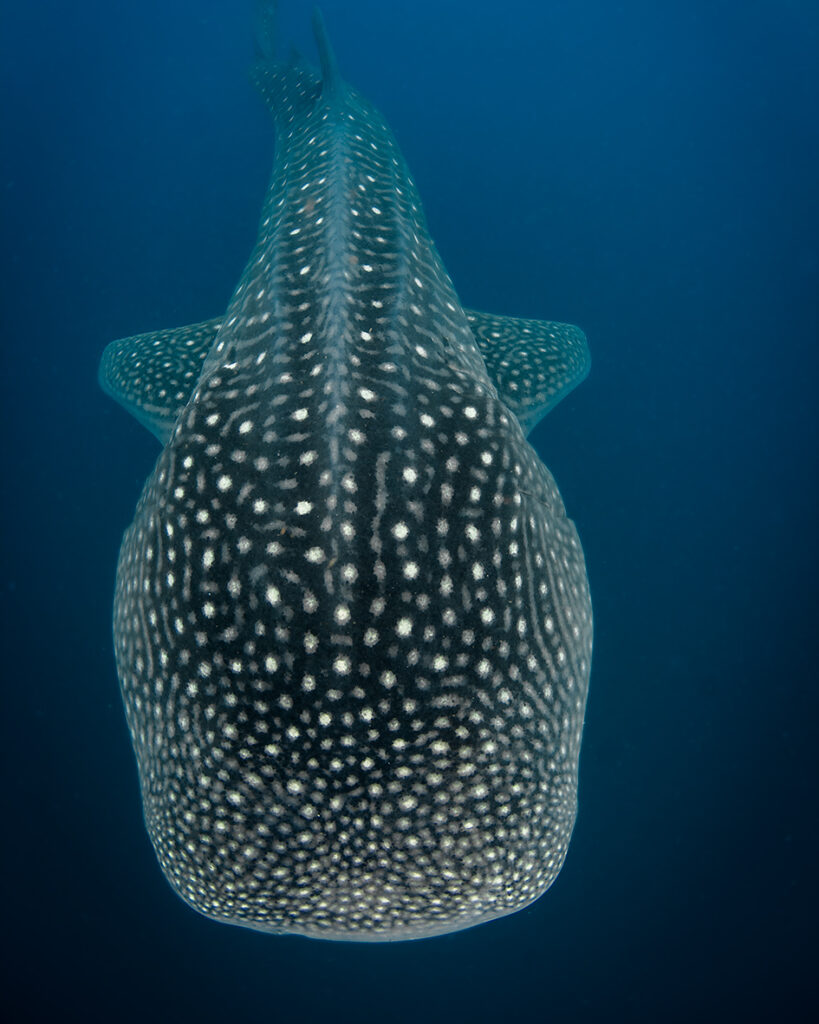
A Guide to Photographing whale sharks and mantas
Special encounters need to be documented and cameras ranging from GoPro video and phones to professional rigs can get great images of whale sharks and mantas in the water and topside.
Using the Ambient Light
I try to pick my subjects based on not shooting directly into the sun. This is not always successful, but if I can get a whale shark with the sun to my back it improves the chances for a great shot. There will be multiple subjects and chances to seek out ideal light direction especially if you have chosen a multi-day trip.
Use a Fisheye Lens
Whale sharks are huge, and it is possible to get close to the subject while abiding by the regulations. Select the widest lens you have – ideally a fisheye prime or fisheye zoom lens: both will give you up to a 180-degree field of view with a reduced minimum focus distance. When you get as close to the shark as you can, you will get the whole thing in.
Fisheye lenses like a 10 – 17mm will be the most popular, especially on crop sensor cameras. Full frame shooters can use lenses such as a 15mm or a 8-15mm circular fisheye. Mirrorless cameras can use an 8mm fisheye.
Compact camera users will need to use a fisheye wet lens on top of the built-in lens. Without a wide lens, compact users will not be able to get the whole shark in the photo and will always have to be too far away.
Compared to photographing other moving subjects like dolphins and sailfish, the drag caused by your large dome port will not be a huge factor. Whale sharks are moving, but more at a fast-walking pace than a running pace.
Know the Regulations for Photographers
Use of strobes is prohibited
Rules governing the use of “selfie sticks” prohibit the use a stick to go closer to the animal than the rules allow so just a short handle is best.
Drones are prohibited without a special permit which needs to be obtained in advance.
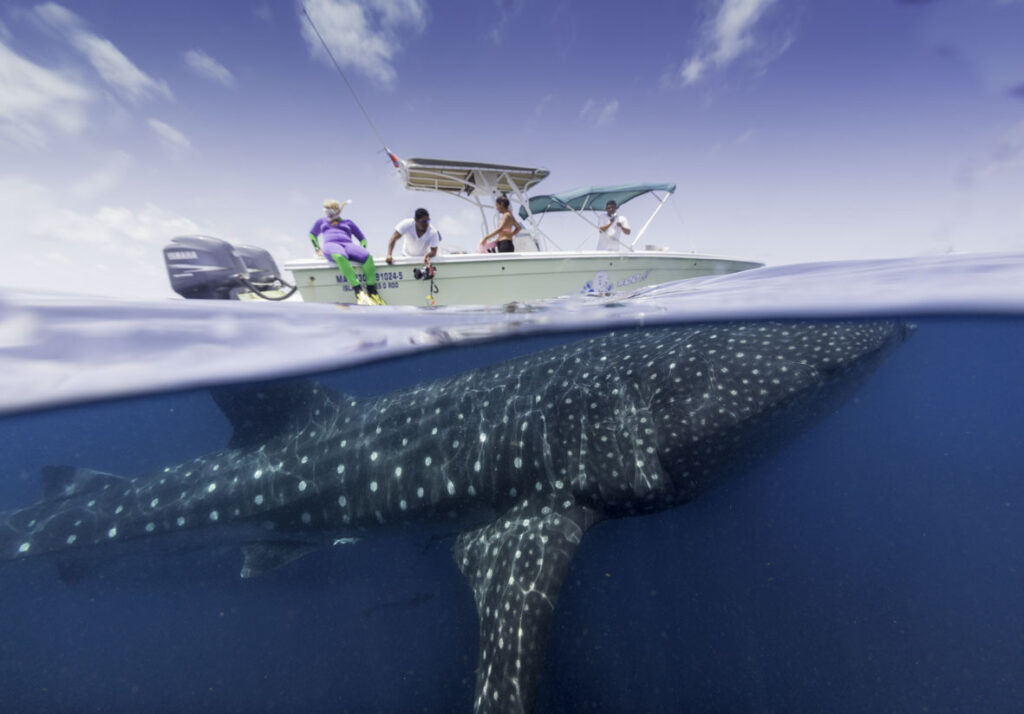
Adapt Settings throughout the day
My method is to start with some manual settings and change them as the daylight changes. I use full manual, but Shutter Priority would be a good 2nd choice. Most of my images are at ISO200 with some ranging up to ISO320 to ISO640 on cloudy days. My shutter speed stays at 1/250 sec or more. You must be able to shoot at a shutter speed fast enough to freeze the moderate movement of the shark and your body.
Shooting Techniques
The whale sharks will be feeding and can change direction at any moment, so pay very close attention to their movement to avoid touching them or being run over.
When using the wide-angle lenses such as those with 180-degree coverage, watch that your fins do not get in the shot!
Look all over the view finder and watch for the tip of tail to swing into view before taking that full length shot.
Mantas: When we find mantas they are in smaller, tighter groups. They also move in circles or random directions up and down and parallel to the water surface. You will need to swim faster and be ready to change depth. They will spook and run away if you get too close. The best compositions are made by getting in front of multiple rays feeding in a line (“train”) and let them come toward you getting shots starting when they are still too far and then getting the last right before moving out of the way. If you move at the right time you can follow up with a side shot as they swim by. The boat captains can help with dropping you in a position ahead of the moving mantas.
Types of Compositions
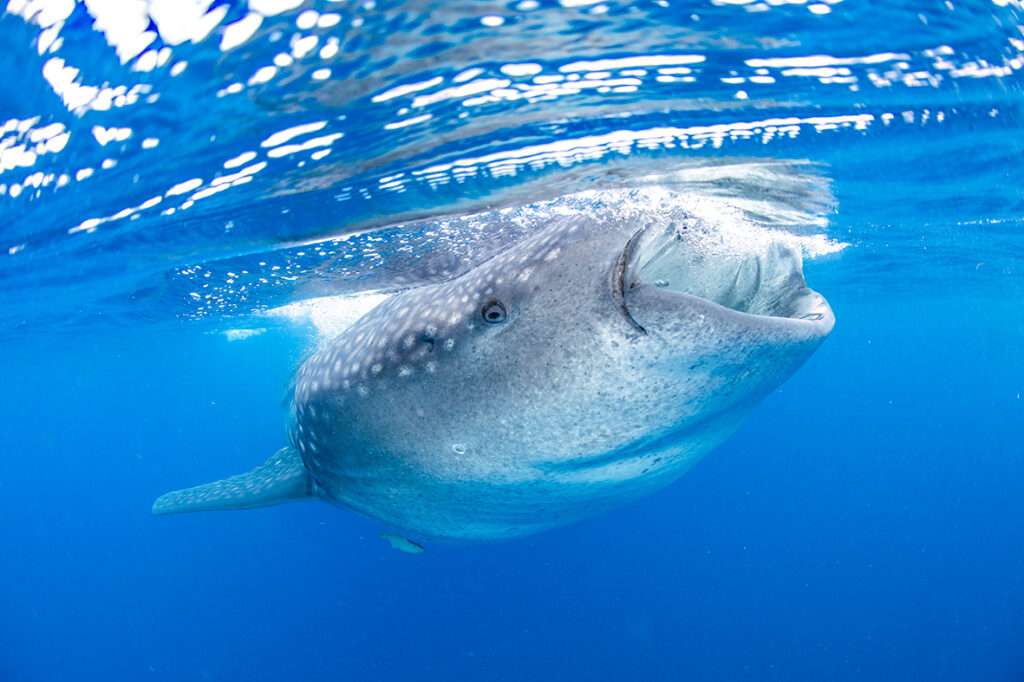
Behavior
Catching the wide-open mouth during feeding either from the front, side, or ¾ angle
Add drama to the feeding image by getting details of the water flowing into the mouth
Position yourself ahead of the shark and wait for it to approach. While photographing, move off to the side to get ¾ angle as it goes by. If it is too late to move, quickly submerge and swim to the side letting it pass over you. You do not want to get hit; those fins are hard and rough.
One of the most dramatic images you can take of a whale shark is a behavior common in Isla Mujeres where the shark shifts into a stationary vertical position to feed, called a “botella.” You will use every bit of your wide lens to capture the image.
Above and Below
When photographing the whale shark near the surface, try capturing a split shot with the fish underneath and the topside scene above. In some cases, the above subject might be boring: Just clouds or sky but try for a boat in the image to give scale and tell a story.
Close up Details
Grab close up shots of eyes, gills, fins, spots, or remora fish when you find yourself too close for the full body shot. You will get chances to get a tail shot as the whale shark swims past you into the distance.
Get Variety
Getting lower in the water, looking up at the subject adds variety and drama to your image collection.
If a whale shark is below the surface, get an image of its back. The spots are one of the most interesting features of the whale shark.
Isla Mujeres is a great base for your Whale Shark Adventure
After a day out on the water with the Whale Sharks and Mantas, it is great to relax and dry out with a walk around through the streets of Isla Mujeres. Lined with fun shops and great restaurants, it is safe and full of the festive feeling of Mexico. For casual or formal meals, varied but always delicious restaurants are plentiful.
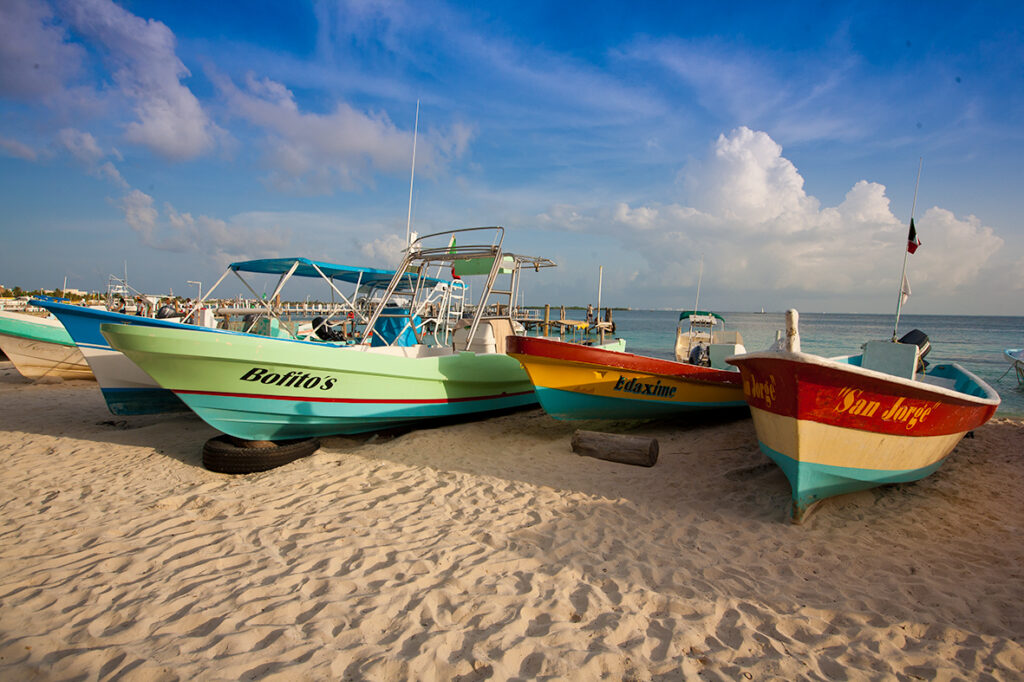
In the last few years, murals of whale sharks, sailfish, and mantas have sprouted up all over town. It is a great street photography outing to find and photograph the best as you explore town and beaches.
Isla Mujeres is ringed with beaches and has a park and historic sight at its south end. The beaches are perfect for swimming and sunning: there might even be a hammock with your name on it. Numerous dive shops on the island will give you opportunities for diving or more snorkeling around the island such as the famous Underwater Statue Museum.
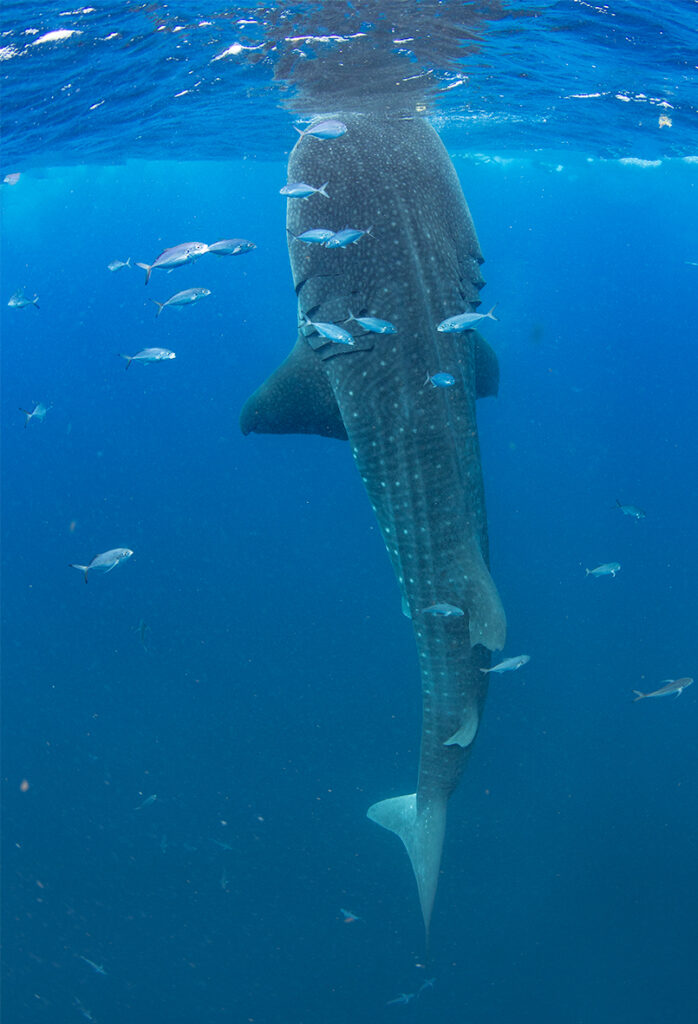
Most visitors come for the unequalled marine wildlife encounters, but Isla Mujeres is a holiday destination as well: the world-famous whale shark and manta encounters is only the beginning of your adventure. While travel is still recovering, Isla Mujeres provides a quality summer get away full of enriching wildlife encounters to appeal to the whole family as well as seasoned underwater photographers.
To join one of my Whale Shark Trips get details here
